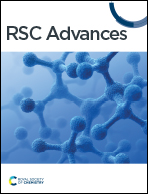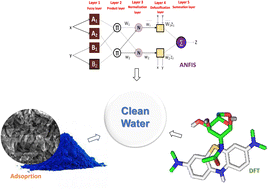
RSC Advances
Subject area
Remediation articles published in the last
6 months

Influence of alkali metal ions (K+ and Na+) on the preparation of magnesium hydroxide hexagonal flakes
Magnesium hydroxide (Mg(OH)2), as a green halogen-free flame retardant, has attracted significant attention in the field of flame retardant composite materials.

RSC Adv., 2024,14, 14640-14647
https://doi.org/10.1039/D4RA00305E
Photocatalytic degradation of methyl blue dye with H2O2 sensing
ZnO nanoparticles impregnated polymer for the degradation of methyl blue dye with H2O2 sensing colorimetrically and fluorometrically.

RSC Adv., 2024,14, 14606-14615
https://doi.org/10.1039/D4RA01354A
Effective separation of dyes/salts by sulfonated covalent organic framework membranes based on phenolamine network conditioning
This study developed a modified polyacrylonitrile (PAN) membrane controlled by a phenol–amine network and enhanced with a sulfonated covalent organic framework (SCOF), aimed at improving the efficiency of textile wastewater treatment.

RSC Adv., 2024,14, 14593-14605
https://doi.org/10.1039/D4RA01736F
A novel layered double hydroxide-based ternary nanocomposite for the effective photocatalytic degradation of rhodamine B
Photocatalytic degradation of organic pollutants is a green and effective route of wastewater treatment.

RSC Adv., 2024,14, 14523-14538
https://doi.org/10.1039/D4RA00685B
Advanced photocatalytic materials based degradation of micropollutants and their use in hydrogen production – a review
The future directions of photocatalytic degradation of micropollutants (pharmaceuticals, dyes, pesticides, etc.) and its role in green fuel production from wastewater are discussed with several examples of modern photocatalysts.

RSC Adv., 2024,14, 14392-14424
https://doi.org/10.1039/D4RA01307G
Unleashing the promise of emerging nanomaterials as a sustainable platform to mitigate antimicrobial resistance
The emergence and spread of antibiotic-resistant (AR) bacterial strains and biofilm-associated diseases have heightened concerns about exploring alternative bactericidal methods.

RSC Adv., 2024,14, 13862-13899
https://doi.org/10.1039/D3RA05816F
Visible-light-induced N-alkylation of anilines with 4-hydroxybutan-2-one
The synthesis of amines through N-alkylation is particularly attractive.

RSC Adv., 2024,14, 14452-14455
https://doi.org/10.1039/D4RA01339E
Upcycling of sugar refining mud solid waste as a novel adsorbent for removing methylene blue and Congo red from wastewater
The feasibility of utilizing the mud solid waste produced during sugar refining as a cost-effective and environmentally friendly alternative for the removal of methylene blue and Congo red from wastewater is presented.

RSC Adv., 2024,14, 13505-13520
https://doi.org/10.1039/D4RA01451K
Enhancing corrosion resistance of mild steel in hydrochloric acid with Chiquita banana sap extract
The corrosion of metals is still a huge challenge for various industries, and the pursuit of effective treatments ensures environmental sustainability.

RSC Adv., 2024,14, 14263-14277
https://doi.org/10.1039/D4RA00132J
Enhanced thermal desorption of chlorinated hydrocarbons by nanoscale zero-valent iron: the effect of in situ dechlorination
The thermal desorption of CHs in contaminated soil was enhanced by the in situ dechlorination effect brought by the addition of nZVI.

RSC Adv., 2024,14, 14254-14262
https://doi.org/10.1039/D4RA01077A
Synthesis and characterization of new composite from modified silica-coated MnFe2O4 nanoparticles for removal of tetracycline from aqueous solution
In this study, a new composite from silica coated MnFe2O4 nanoparticles, diethylenetriamine, 3-chloropropyl trimethoxysilane and Mg–Al Layered Double Hydroxide (Mg–Al LDH/DETA/CPTMS/SCNPs) composite was synthesized.

RSC Adv., 2024,14, 14170-14184
https://doi.org/10.1039/D4RA01007H
Ag/AgBr-oxygen enriched g-C3N4 for efficient photocatalytic degradation of trimethylamine
In this study, Ag/AgBr–O-gCN samples with ternary Z-type heterojunctions were prepared by in situ photoreduction using water as the reducing agent for generating Ag/AgBr active species and oxygen doping.

RSC Adv., 2024,14, 14068-14079
https://doi.org/10.1039/D4RA02395A
Mechanistic explanation and influence of molecular structure on chemical degradation and toxicity reduction by hydroxyl radicals
The study elucidated environmental toxicity impact along with mechanistic degradation of organic emerging contaminants with different aromaticity and aliphaticity.

RSC Adv., 2024,14, 13926-13933
https://doi.org/10.1039/D4RA00827H
The effects of crystal structure on the chemical durability of yttrium disilicate
Elemental release: amorphous Y2Si2O7 is leached in pH 3 nitric acid. Post-leaching characterization of the leachate and pellet surface indicates a preferential release of Y, and the formation of an SiO2 alteration layer on the surface of the pellet.

RSC Adv., 2024,14, 13997-14007
https://doi.org/10.1039/D4RA01072H
Construction of a novel ternary synergistic CuFe2O4–SnO2-rGO heterojunction for efficient removal of cyanide from contaminated water
Many industrial effluents release cyanide, a well-known hazardous and bio-recalcitrant pollutant, and thus, the treatment of cyanide wastewater is a major challenge.

RSC Adv., 2024,14, 13850-13861
https://doi.org/10.1039/D4RA02217C
Study adsorbents based on bent-Al13-CS-CTA and its application to the removal of CR from wastewater
For rapid and efficient removal of Congo red (CR) from aqueous solutions, a composite of bent-Al13-CS-CTA was prepared from bentonite (bent), chitosan (CS), citric acid (CTA) and Al13 compounds.

RSC Adv., 2024,14, 13817-13826
https://doi.org/10.1039/D4RA00197D
Degradation of fluoride in groundwater by electrochemical fixed bed system with bauxite: performance and synergistic catalytic mechanism
This study demonstrates that the coordinated defluorination system (IE-BA) which is made up of the industrial aluminum electrode and natural bauxite for fluoride removal. The defluorination mechanism of the IE-BA system is discussed.

RSC Adv., 2024,14, 13711-13718
https://doi.org/10.1039/D4RA01359J
Dispersive micro solid phase extraction of glibenclamide from plasma, urine, and wastewater using a magnetic molecularly imprinted polymer followed by its determination by a high-performance liquid chromatography-photodiode array detector
The present study describes the development of a simple and selective analytical method for dispersive micro solid phase extraction and determination of glibenclamide (GLB) using magnetic molecularly imprinted polymer (MMIP) as a sorbent.

RSC Adv., 2024,14, 13168-13179
https://doi.org/10.1039/D4RA00452C
Efficient dye adsorption of mesoporous activated carbon from bamboo parenchyma cells by phosphoric acid activation
In this study, mesoporous activated carbon was prepared from bamboo parenchyma cells for MB removal from water.

RSC Adv., 2024,14, 12873-12882
https://doi.org/10.1039/D4RA01652A
Superhydrophobic foam combined with biomass-derived TENG based on upcycled coconut husk for efficient oil–water separation
Ocean ecological environments are seriously affected by oil spilling and plastic-debris, significantly reducing marine pollution via using biocomposite production from natural fiber reinforcement is a friendly way to deal with marine oil pollution.

RSC Adv., 2024,14, 13005-13015
https://doi.org/10.1039/D4RA01841A
Enhanced photocatalytic performance of ZnO under visible light by co-doping of Ta and C using hydrothermal method
C, Ta-co-doped ZnO nanoparticles (Eg = 2.88 eV), prepared by hydrothermal method, were used as a photocatalyst under visible light to remove organic contaminants in aquatic environments.

RSC Adv., 2024,14, 12954-12965
https://doi.org/10.1039/D4RA00579A
Application of cold-adapted microbial agents in soil contaminate remediation: biodegradation mechanisms, case studies, and safety assessments
Analyzed the microorganisms cold-adapted mechanism, and summarized the degradation pathway of nitro-aromatic compounds. Evaluated safety of microbial agents according to the existing application restoration cases under freeze-thaw cycles condition.

RSC Adv., 2024,14, 12720-12734
https://doi.org/10.1039/D4RA01510J
Thermally modified nanocrystalline snail shell adsorbent for methylene blue sequestration: equilibrium, kinetic, thermodynamic, artificial intelligence, and DFT studies
The quest for an efficient and sustainable adsorbent material that can effectively remove harmful and hazardous dyes from industrial effluent has become more intense. Thermally modified nanocrystalline snail shell is a new biosorbent for removing methylene blue dye from contaminated wastewater.

RSC Adv., 2024,14, 12703-12719
https://doi.org/10.1039/D4RA01074D
Amplification of photocatalytic degradation of antibiotics (amoxicillin, ciprofloxacin) by sodium doping in nano-crystallite hydroxyapatite
Sodium-doped hydroxyapatite (Na_HAp) was synthesized for the enhanced photocatalytic degradation of amoxicillin and ciprofloxacin.

RSC Adv., 2024,14, 12386-12396
https://doi.org/10.1039/D4RA00126E
Resistance and durability of fly ash based geopolymer for heavy metal immobilization: properties and mechanism
This study employed geopolymerization technique to solidify MSWI fly ash, aiming to facilitate its reutilization. The FA based geopolymers exhibit strong durability and mechanical qualities, making them suitable for a variety of applications.

RSC Adv., 2024,14, 12580-12592
https://doi.org/10.1039/D4RA00617H
Browse by Subject
- All (336 articles)
- Atomic/elemental (14 articles)
- Bioanalytical (65 articles)
- Chemometrics (30 articles)
- Crystallography (164 articles)
- Electroanalytical (57 articles)
- Imaging/microscopy (32 articles)
- Mass spectrometry (22 articles)
- Medical diagnostics (77 articles)
- Microfluidics (17 articles)
- Nanoanalysis (20 articles)
- Separation science (27 articles)
- Spectroscopy (95 articles)
- All (272 articles)
- Bioinorganic chemistry (49 articles)
- Bioorganic chemistry (27 articles)
- Biotechnology (51 articles)
- Cellular chemistry (56 articles)
- Computational (84 articles)
- Drug delivery (78 articles)
- Drug discovery (181 articles)
- Imaging/diagnostics (15 articles)
- Molecular biology (6 articles)
- Nanotechnology (44 articles)
- Natural products (30 articles)
- Pharmacology (85 articles)
- Photobiology (15 articles)
- Polymorphism (pharma) (1 article)
- Structural biology (12 articles)
- Toxicology (3 articles)
- All (555 articles)
- Biomaterials (101 articles)
- Biopolymers (99 articles)
- Carbon materials (100 articles)
- Composites (247 articles)
- Electronic materials (96 articles)
- Encapsulation (1 article)
- Energy applications (84 articles)
- Films/membranes (82 articles)
- Gels & soft matter (36 articles)
- Inorganic materials (48 articles)
- Medical materials (66 articles)
- Nanomaterials (125 articles)
- Optical materials (51 articles)
- Organic materials (55 articles)
- Polymers (133 articles)
- All (349 articles)
- Assembly (11 articles)
- Biotechnology (30 articles)
- Carbon nanomaterials (80 articles)
- Imaging/microscopy (17 articles)
- Nanoanalysis (42 articles)
- Nanocatalysis (31 articles)
- Nanomaterials (217 articles)
- Nanomedicine (43 articles)
- Nanotoxicology (55 articles)
- Optical nanomaterials (33 articles)
- Synthesis (12 articles)
- All (173 articles)
- Bioorganic (17 articles)
- Catalysis (46 articles)
- Fine chemicals (26 articles)
- Natural products (23 articles)
- Physical organic (8 articles)
- Stereochemistry (11 articles)
- Supramolecular (3 articles)
- Sustainable synthesis (35 articles)
- Synthetic methodology (100 articles)
- Total synthesis (13 articles)
- All (320 articles)
- Biophysics (2 articles)
- Charge transfer (28 articles)
- Electrochemistry (13 articles)
- Energy research (18 articles)
- Imaging/microscopy (5 articles)
- Kinetics & dynamics (40 articles)
- Materials (104 articles)
- Mechanics (34 articles)
- Nanoscience (69 articles)
- Photoscience (26 articles)
- Quantum & theoretical (90 articles)
- Simulations (23 articles)
- Single molecules (40 articles)
- Soft matter (5 articles)
- Spectroscopy (7 articles)
- Surfaces & interfaces (71 articles)